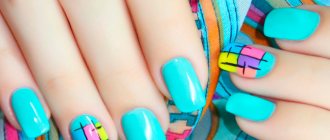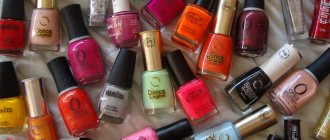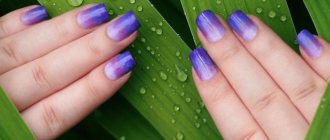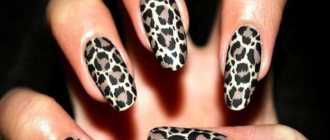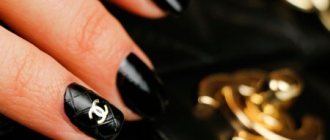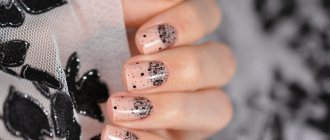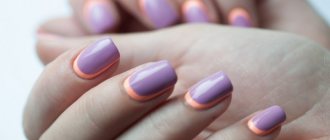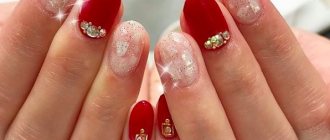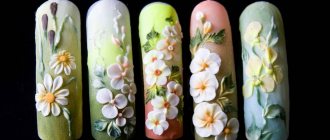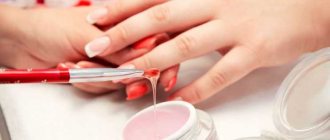Designer manicure techniques excite the imagination. Many of them require real artistic flair, familiarity with the fine arts, and painting skills. Watercolor painting on nails is a subtle type of art.
Art design is improving day by day, setting new trends and tendencies in drawings and ideas for manicure. But watercolor is a subtype of nail art that requires jewelry work.
Attention! Creating watercolor designs on nails takes more time and resources from the artist than a standard gel coating. The complexity of unusual manual techniques may cause an increased price for manicures.
Features of watercolor technique
Watercolor is a nail art technique used to embody design ideas. This method of decorating nails is gaining popularity among the top, leading trends from the end of the 2020 season until the 2022 autumn-winter season, including the spring-summer season. Winter watercolor is just as popular as its other varieties.
Watercolor painting is characterized by a sophisticated design: from the application of faded stains to the effect of artistic painting. The paint creates a unique composition on the nails, maintaining a balance of translucent, pastel colors. Also, watercolor can become rich and colorful if desired and necessary. Depends on the choice of design or pattern.
The base plays one of the key roles in the execution of the technique. A correctly selected base allows you to recreate a smoky, multi-dimensional spreading effect on your nails. The effect of watercolor paint can appear in a single form, creating an expressive transition in the composition of the painting. You can also decorate all or several nails with it. This will not negatively affect the overall look, but, on the contrary, will allow the manicure to shine in a creative design.
Does not require an ordinary base. Can be used on both light and dark surfaces. The main thing is that the color of the decor stands out and shines against the background of the main paint.
The coating may be sticky during application. It is necessary to handle it carefully and prudently during the procedure. For fixing, the same lamp is used as for gel polish.
What do we need
Watercolor nail design gets its name because of its similarity to the watercolor technique in painting. To verify this, just look at the photo of watercolor painting on the nails. The same shades and light semi-liquid paints are used, creating a spreading effect. However, it is worth noting that for painting the plate, it is not school paints that are used, but real artistic watercolors. It has a different composition and production format, due to which it fits better on the surface.
But not every paint can be topped with a layer of gel. This suggests that choosing the material for such a design should be done with special care.
Watercolor painting is applied to nails with special manicure brushes. They are quite thin and vary in length and thickness. For example, a brush can be not only size zero, but also size 00.
Watercolor is diluted in ordinary cold water, so achieving the desired thickness for work will not be difficult. As with drawing on paper, a palette is used to mix colors. In addition to watercolors, you can use acrylic-based paints in painting, which are also diluted with water. But when working with them, you must remember that it is impossible to remove dried acrylic from the brushes, so you should not let them dry while painting.
When replacing one brush with another, more suitable in thickness, the used brush must be washed immediately. In addition to watercolors and acrylics, some people use diluted gel polish. Since it is too thick for painting, it is diluted with topcoat or concealer.
Pros and cons of watercolor technique
If we dwell in more detail on the characteristic advantages of designing with watercolors, we can highlight the arguments in favor of the technique:
1. Incomparable visual effect. Smoky spreading and blurred contours give the nails a sensuality, tenderness and romance. Not every nail art method can beat watercolor in terms of expressiveness and sophistication of execution.
2. Uniqueness, originality. The likelihood that watercolor paintings on nails will be repeated is close to zero. Each composition brings something individual; patterns rarely overlap with each other. This guarantees a personalized design that no one else will have.
3. Volume, multidimensionality. Many people call this technique expressive due to the “blooming bud” effect. Motifs depicted in watercolor seem tangible. And also convex due to the peculiarity of spreading in the middle and saturation at the borders of the contours.
4. The length requirement is not important: painting with watercolors looks good on both long and short nails. Contrary to popular belief, short nails can also provide plenty of space for creativity.
5. Convenience, functionality. To create a nail design in this design, you do not need a huge arsenal of tools. All you need is to stock up on everything you need to start creating beauty.
6. There is no need to use separate methods for removal. Paints along with varnish can be removed with a machine or other handy means in less than fifteen minutes.
Even this dazzling nail design may have its drawbacks:
- The technique cannot be performed without auxiliary tools. You will need to purchase additional things, use special varnishes and brushes.
- Varnish and auxiliary tools will need to be stored in special conditions. And also use with caution to prevent spreading or thickening.
- The palette for applying watercolor paints to nails is not very diverse. This can encourage you to experiment with mixing and combining colors.
- A manicure for short nails will require patience, meticulousness and skill. The process can become more labor intensive due to the short length of the coverage area.
- To master this nail art method, a separate course will be required for those who are encountering subtle fine art techniques for the first time. It is possible that you will have to take a special master class (mk on nail art). From the photo it is difficult to estimate step by step the scale of the work ahead. In this regard, it is advisable to take private or group lessons or study and practice using videos.
It is very interesting and useful to know about manicure with abstraction on nails and 12 fashionable techniques, read the article: - https://uroki-manikura.ru/abstraktsiya-na-nogtyah-foto-novinki-dizajna-risunki-poshagovo/
Advantages and disadvantages
A lot of advantages make this type of design one of the most attractive. For example, if you do not want to use specialized tools, ordinary improvised devices are sufficient. Well, you can get a beautiful design even on the first try, which is good news. A truly endless number of pattern options will be another nice bonus.
Of the shortcomings, only one can be highlighted - you need to work quickly and carefully. After all, if the varnish begins to harden, it is unlikely that it will be possible to correct the drawing. We'll have to start all over again. And a hand that trembles at the wrong time can put an end to your efforts.
Tools for watercolor design
The technique of drawing sketches, landscapes or floral motifs cannot do without the necessary assortment at all stages of preparation:
- The greatest attention is paid to the paint, its properties and quality. The durability of the manicure and the unpretentiousness of its appearance depend on the structure. It is better to buy in stores whose specialty is based on nail art products.
- The process of drawing a picture is also impossible to carry out without brushes. If we paint with watercolors, then it is worth acquiring different subtypes: thin, hard, lush, long, short. It is most convenient to purchase a set with the necessary varieties. The thickness of the brush is proportional to the amount of work on the nail plate.
- Foil, paper, and a container of water may also come in handy during the work. When mixing and washing out shades, it’s almost impossible to do without them. You should ensure their availability in advance.
Important: during the entire procedure, the manicure brush must be kept wet. Otherwise, applying paint will be much more difficult.
The whole process can take quite some time. If it is complicated by additional decorations, such as sparkles, rhinestones, rubbing or other techniques, then the work time is extended even more. You should not forget about this by planning your hours in advance.
Ideas for watercolor manicure
Using watercolor paints you can create amazing, rich paintings on your nails. Various kinds of painted prints, stains and complete images are born during this process:
- Foliage, greenery, flowers . Natural compositions that convey the riot of vegetation always remain among the top popular ones. Among them you can both find original new items and repeat classic stories.
- Wave patterns repeating seascapes. Sunny beaches and sea bays are also possible using this technique. They can convey the feeling of a foamy wave with their washes.
- Smoke effect . Plumes of smoke can appear on a person’s nails if you use watercolor paint.
- Marble stone effect . Paint can express the visual effect of a cool marble surface. For the base, a white or black base is used.
- Abstract manicure . It can be interpreted in different ways and express anything. It all depends on the angle of view and individual interpretation.
- Reptile pattern . Scales of black or other reptiles are an extraordinary option for nail art. Its rarity can add a predatory mystique to any individual.
It is not necessary to limit your imagination to familiar images or follow beaten paths. Watercolor allows you to experiment. It’s enough to try new ideas on tips. And in the future, after practice, carry out art composition on clients.
Useful information about the variety of nail designs - drawings using wet gel polish, read the article: -
Watercolor manicure with floral print
For many years, floral designs have been perhaps the most popular type of nail design. It is used as a decoration for a jacket, a single-color covering and many other design options. Therefore, it is not surprising that flowers are increasingly being painted using watercolor techniques. This allows you to mix shades in the desired proportions to achieve suitable tones. It is noteworthy that this technique does not involve multi-layer application of paints. Because the main thing is to apply them carefully, avoiding bald spots.
Please note that if the chosen paint color is too dark, you can dilute it with white watercolor. After application, the pattern will have a smoother, gentle transition. And of course, avoid too clear, thick contours. In this case, this is simply inappropriate.
If this application technique seems too complicated for you, there are alternative solutions. First of all, we are talking about ready-made pictures, which are presented as slider designs or stickers. Thanks to them, you can apply the design symmetrically or select a specific part of it. In addition, stickers are often used to design lunar manicures using watercolor techniques. Just a few rhinestones or sparkles and the design will look incredibly beautiful.
Watercolor technique allows you to create an amazingly beautiful, elegant manicure for every taste. To hone your skills, experiment, try to implement your ideas on tips. Over time, you will be able to achieve the desired effect even by making your own design.
Preparation stage
Before applying the design, you will need to prepare the nail for the process. This takes its own time. Most often, masters highlight it as a preparatory stage.
Having decided what kind of manicure or its ornament will be, you should prepare a base for it. The nail “canvas” is designed as follows:
- Remove the covering if present. Set the desired shape and length. Treat hangnails and cuticles.
- Remove glossy shine from the surface.
- Apply base coat, followed by varnish. You can secure it with a top coat.
- After the layers have dried in the lamp, the nail is roughened.
Upon completion of these steps, the nail will be ready to apply the image.
Tip: each layer must be heated in a lamp for deep drying so that the varnish adheres well. And the drawing was clear.
Drawing stages
Painting with watercolors can be difficult for beginners. You have to learn many nuances. What paint is suitable for this, how to paint with it, what step-by-step diagram will be necessary and useful.
To understand how to draw a picture, there are instructions with integral steps:
- The elements are applied in the thinnest layer. Spreading depends on the subtlety and delicacy of the work. The thinner it is, the better the visual effect it reproduces.
- The effect can be weakened by frequent movements of the brush. They should be minimized.
- The gradient needs to be controlled. If necessary, it can be stretched with a brush.
- After each completed stroke, it is advisable to send the nail to dry. Keep in the lamp for 15 to 30 seconds.
- It is imperative to polymerize the watercolor on your nails to make the design complete. An ice machine is used and exposed to ultraviolet radiation for 2 minutes.
- As a final step, the nail design is covered with a top coat or finish.
- Be sure to dry it at the end.
At this point, the process of applying watercolors to manicured nails is considered complete.
This is interesting and useful to know: - 100 ideas for unusual nail design, read the article: - https://uroki-manikura.ru/neobychnyj-dizajn-manikyura-novinki-modnye-trendy-i-foto-nogtej/
Techniques for painting nails with watercolors
To make your manicure look great on your hands, you need to master the right techniques to create a watercolor design. These include:
- Washing.
Thanks to this technique, you can create bright, colorful flowers. A pastel shade is applied to the nails, which must be heavily diluted with water. After the first layer has dried, apply the second and third. This will make the midtones deeper. Attention! There is no need to apply a fourth coat. - Raw. A smear is carefully applied to the still wet layer of varnish, which can be done several times. The main thing is to notice those very smooth transitions for which such a manicure was created. If you need to enhance the color in some places, you should also use a brush on a “wet” layer.
- Monochrome range. In any situation, designs made in one color look advantageous on nails. This kind of work is easy and quick to do, and the results will please you for a long time. First you need to draw the contours and leave them for a while to dry. Next, you need to moisten the brush in water and fill the gaps inside. At the end of the work, draw the contours again to give clarity. Abstract drawings look good using this technique.
- Stained glass. The principle of performing the technique is very similar to the one mentioned above. The key difference is that it is difficult to imitate stained glass, which in some works requires mica and the use of a palette of paints.
- Watercolor gel polishes on French nails. A typical French manicure, already loved by fashionistas, has been reworked by masters: now it is used as a canvas for watercolors. In addition, the result is very interesting.
- White watercolor strokes. To perform this technique you will need a flat brush and watercolor white. Apply a little white paint to the edge of the nail. You can also use a medium-thick brush and, making small strokes, change the background of the picture.
- Blurring with a flat brush. You can complement your floral design using the amazing property of watercolor that it blurs even with a small amount of water. To do this, you need to take the desired shade and blend it with a brush. In this way, a color change can be achieved.
- Double stroke technique. Perfect for drawing voluminous colors that combine several shades. The execution process is very simple: 2 colors are applied to the brush, not mixed with each other. And with each contact with the nail, a double stroke is obtained, consisting of several highlights at once.
Master class on watercolor paintings on nails
Liner is one of the means of drawing watercolor techniques on nails, allowing you to draw small details of the design. With its help it is very convenient to depict animals, faces and landscapes.
To create a design using a liner you will need:
- base coat;
- varnishes of burgundy, silver and pink colors;
- liner;
- small rhinestones;
- fixer
First, a base is applied to the nail to level the surface of the plate. After it dries, cover it with pink varnish in 2 layers. Then, from the upper left corner, draw 2 parallel burgundy lines - one thicker, the second thinner. Now the same stripes are drawn from the right corner. Add a silver line and a fixative, and apply rhinestones using a toothpick. A wonderful manicure is ready!
Step-by-step photo of watercolor manicure with gel polishes
How to paint three-dimensional flowers on nails with watercolors step by step
As practice shows, drawings on nails with watercolors made on a white background are more expressive. Therefore, for voluminous flowers, it is worth preparing your nails by applying a light canvas varnish for painting. Then follow these steps:
- Using a thin brush, pick up a crimson shade and paint a single floral element. Precision is not needed, you need to act quickly and carefully.
- It is worth creating the effect of a “tattered” pattern, as if the image continues behind the extension of the nail on the hand.
- Using a green tint, add leaves to the flower. Moreover, it is better to sharpen the tip of the sheet to give it a natural look.
- To create a relief for the design, apply black color in the center of each flower.
- Next, continue to highlight the outline of the petals.
- Cover with clear sealing varnish.
Manicure using stained glass watercolor technique
Sealing or securing
The final stages play a significant role in the final look of the manicure. They should be given no less attention than composing the composition.
Tips for consolidation that may be useful at the end of all stages:
- To seal, you can use a two-in-one top or a regular rubber top.
- If you used rubber, you will have to reapply a regular gel polish topcoat. This will maintain the durability of the coating and healthy shine.
- A top with a two-in-one effect does not require re-coating.
- Do not forget about removing the dispersion layer after drying in the lamp.
General recommendations
In the process of mastering the technique, many beginning masters have questions. Is it possible to draw only with a certain method or are some deviations allowed?
The design can be chosen to suit your taste. But watercolor does not allow many liberties in the order of actions at the time of design. It’s better to draw the picture on your nails step by step so that you get a nice design in the end.
Attention! When painting on nails with watercolors, a matte finish is used. Gloss won't work. Even if it was taken from a quality brand.
When choosing colors, it is better to limit yourself to flesh, light or dark tones. You should not abuse other colored paints, which can spoil the displayed ornament. Red, flashy or saturated bases can significantly damage the integrity of the design.
Otherwise, if all conditions are met, a watercolor composition can turn out beautiful and memorable.
